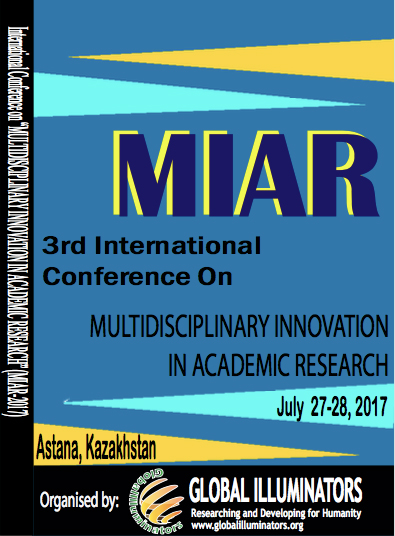
MIAR Proceedings
MIAR Proceeding
Volume 3, Pages 1-61
2017 MIAR Conference on “MULTIDISCIPLINARY INNOVATION IN ACADEMIC RESEARCH” (MIAR 2017)
July 27-28, 2017 Almaty, Kazakhstan
Edited by Dr. Ahmed Saddam
pp. 1-145 (2015)
2015 MIAR Conference on “MULTIDISCIPLINARY INNOVATION IN ACADEMIC RESEARCH” (MIAR 2015)
pp. 1-57 (2016)
2016 MIAR Conference on “MULTIDISCIPLINARY INNOVATION IN ACADEMIC RESEARCH” (MIAR 2016)
pp. 1-61 (2017)
2017 MIAR Conference on “MULTIDISCIPLINARY INNOVATION IN ACADEMIC RESEARCH” (MIAR 2017)
Track: Business, Management, and Economic Studies
Exchange Rate, Bank Loans Performance and Monetary Policy in Kazakhstan
Pages 1-17
Gulnara Moldasheva
Abstract
Track: Social Sciences and Humanities
A Survey Study on Imagination, Creativity, and Innovative Thinking of Undergraduate and Graduate Students in Taiwan
Pages 18-25
Dengchuan Cai, Nyan-Myau Lyau, Chuan-Yu Chang, Sheng-Chun Huang, Jia-Wei Jhang
Abstract
Developing Trilingual Education in Universities of Kazakhstan
Pages 26-32
M.Zh. Tusupbekova, M.A. Idrissova, B.G. Smagulova, Zh.K. Nurmanova, K.K. Kulanova
Abstract
Implementation of the Official Language Policy and the Linguistic Reality in Astana, Kazakhstan
Pages 33-43
Tussupbekova Madina, Zharkynbekova Sholpan, Abdualiuly Bekzhan, Konyratbayeva Zhanar, Kulmanov Kuandyk
Abstract
Astana is a culturally developing young capital of Kazakhstan. Various ethnic communities as Kazakhs, Russians, Ukrainians, Tatars, Armenians, Azerbaijanis, Jews, Belarusians, Georgians, Moldovans, Tajiks, Uzbeks, and others live in Kazakhstan. Many languages function and coexist. The city can rightly be called multi-ethnic because of its community is heterogeneous. Despite the peculiar ethnic composition and linguistic configuration, the study of functioning language policy in Kazakhstan has been limitedly researched. The purpose of the study is to examine the linguistic landscape of Astana city to the current language policy and linguistic reality. In other words, by examining the linguistic landscape, the research aims at exploring the implementation of the current language policy in Astana and functioning of Kazakh, Russian and English languages displayed on the public road signs, advertising billboards, street names, place names, commercial shop signs, and public signs on government buildings.
Track: Engineering and Technology Studies
Comparison of Support Vector Machine (SVM), Sediment Rating Curve (SRC) and FAO Approaches to Predict Suspended Sediment Load of Karoon River, (IRAN)
Pages 44-48
Emamgholizadeh, Samad, Karimi Demneh, Razieh
Abstract
The accurate estimation of suspended sediment yield of rivers is one of the most important parameter in water engineering and hydraulic structures that has a comprehensive effect on water resource management. Widespread studies have been done in these contexts up to now. In these researches, a relationship is established between flow discharge and sediment discharge which are uncertain. So, researchers tren to use of artificial intelligence techniques to predict suspended sediment load of rivers. In this study, the support vector machine approach (SVM) is used to estimate suspended sediment load of Karoon River in Mollasani hydrometric station located in southwest of Iran. The results are compared with the results of two traditional sediment rating curve (SRC) and FAO approaches. Findings showed that SVM model with correlation coefficient (R2) of 0.97 and 0.73 and root of mean square error (RMSE) of 46117 (ton.day-1) and 61689 (ton.day-1) had better performance than SRC model (with R2 (RMSE) of 0.72 (173913 ton.day-1) and 0.49 (222028 ton.day-1)) and FAO model (with R2 (RMSE) of 0.72 (284840 ton.day-1) and 0.49 (302062 ton.day-1)) for the training and testing levels, respectively .
Evidence for Deeper Hydrocarbon Exploration: New Insight from the
Hydrocarbon Plays in the North Celtic Sea Basin
Pages 49-55
Godspower I. Onyenanu
Abstract
The timing of hydrocarbon maturation has an important implication for deeper hydrocarbon prospecting. Results from series of basin models for the North Celtic Sea Basin display the implications of structural evolution on the timing of hydrocarbon maturation, charge history and trap formation, sealing potential, remigration and phase change. This study adds to previously published work, which were based on 1D modeling, by generating 2D models using PetroModTM software. Seismic data has been used to reconstruct the regional structural framework, while the integrated wireline logs and geochemical data provided lithological, porosity and palaeothermal information. The palaeothermal values and available vitrinite reflectance data has been used to calibrate the models to present day heat flow of 52mW/m2. Results from this study shows that hydrocarbon maturation, generation and migration were affected by the Triassic and Late Jurassic rifting activities, resulting in a complex charge history and trap modification through time. The Late Jurassic source rocks (PurbecK) attained peak maturation for oil in late Cretaceous while the Early Jurassic Source rocks (Liassic and Toarcian) entered the gas window in Early Cretaceous. Analysis of the petroleum systems for deeper hydrocarbon prospecting suggests that two expulsion phases of hydrocarbons occurred in the Late Jurassic and Early Cretaceous respectively. This result suggests that there is potential for charge of suitable reservoir facies at depth if the reservoir quality can be preserved. Hydrocarbon preservation risk is low in anticlinal structures but there is a high risk of hydrocarbon remigration along modified fault planes in fault dependent structures. The study demonstrates how basin geometry has changed through time, due to multiple tectonic events, leading to modification of older traps.
A Study on Wave Power Generation System Utilization of Bell-Mouth Effect to Pairs of Water Chambers
Pages 56-61
Seong Beom Lee1, Kesayoshi Hadano2, Guk Hwan Sin3, Byung Young Moon
Abstract
The following research suggests a novel wave power generation system for ocean energy. A system has to satisfy all four durability, constructability, efficiency in economy and power conversion to certain extent for it to be put into practical use. These four conditions are met by having a water chamber installed in a series on a breakwater, and rotating the hydraulic turbine with the difference in water level from the forward and reverse directions of the Bell Mouth effect. The water transportation model had been designed and put into numerical analysis. According to the analysis, the output power is highest when the wave height is large, the wave cycle short, and the water depth deep. The results are to be used later on as reference data to express the change in water level and flux inside the water chamber without inconsistency.
